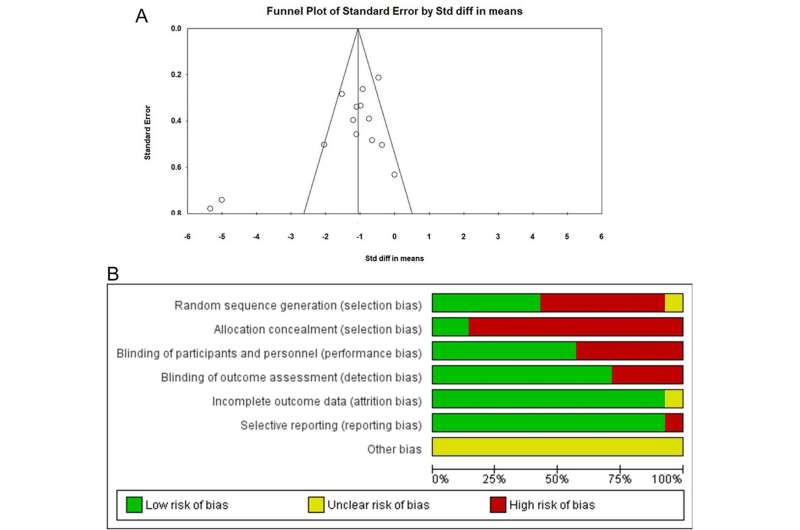Strength training practiced with moderate to vigorous intensity two or three times a week is an effective way to mitigate arterial hypertension (high blood pressure), according to a Brazilian study published in the journal Scientific Reports.
The mechanisms behind the lowering of blood pressure by aerobic exercise are well studied, but little research has been done on the effects of strength exercise on hypertension along similar lines to this review conducted by researchers at São Paulo State University (UNESP).
Led by Giovana Rampazzo Teixeira, a professor in UNESP's Department of Physical Education at Presidente Prudente, the group analyzed over 21,000 scientific articles and conducted a Cochrane meta-analysis, considered the gold standard for systematic reviews. According to the authors, the analysis focused on the effects of variables such as age, training dose-response, load, volume and frequency.
Cardiovascular diseases are the leading cause of death worldwide, and high blood pressure accounts for 13.8% of deaths from such diseases. Arterial hypertension is diagnosed when systolic blood pressure exceeds 140 millimeters of mercury (mmHg) and/or diastolic pressure exceeds 90 mmHg. It is a multifactorial disorder triggered by such problems as an unhealthy diet, drinking too much alcohol, smoking and a sedentary lifestyle.
Strength training has long been known to be a therapeutic option, but without sufficient clarity as to the most effective protocols. In this study, the sample comprised 253 hypertensive subjects with a mean age of 59.66, and the meta-analysis focused on baseline and post-training hypertension responses to controlled studies that assessed the effects of training for eight weeks or longer.
"We were interested above all in the volume and intensity found sufficient to achieve a significant blood pressure reduction. On average, eight to ten weeks of strength training led to a reduction of 10 mmHg in systolic pressure and 4.79 mmHg in diastolic pressure," Teixeira said.
The study showed that effective results appeared around the twentieth training session. BP remained lower for about 14 weeks after training ended. "In clinical practice and gyms or fitness centers, strength training can be a treatment option for people with high blood pressure as a non-pharmacological intervention as long as you know enough about the key variables and take the subject's goals into account," Teixeira said.
Systematic review
For a long time, only aerobic training was prescribed to treat high blood pressure, and molecular studies focused almost entirely on the effects of this type of exercise. "Strength training was recently included in the Brazilian guidelines on the management of arterial hypertension, but much more research is needed in order to garner more robust evidence. Future studies should investigate the molecular mediators responsible for lowering vascular and blood pressure during strength training," Teixeira said.
The systematic review analyzed a total of 21,132 scientific articles in search of wide-ranging and robust evidence of the effects of strength training on HBP. Previous reviews on the topic found such evidence, but this study innovated by garnering additional evidence on the influence of age, load, intensity and frequency.
After excluding 21,035 articles that did not meet the objectives of the review, the researchers excluded 43 of the remaining 97 articles owing to duplication, leaving 54 articles for full-text analysis. Fourteen were considered relevant for inclusion in the systematic review.
The results of the analysis showed that strength training was most effective in terms of lowering blood pressure in protocols with moderate to vigorous load intensity, a frequency of at least twice per week, and a minimum duration of eight weeks.
Moderate to vigorous load intensity was defined as more than 60% of the heaviest weight subjects could lift just once, known as the one-repetition maximum, or 1RM, so that for a 1RM of 10 kg, the most effective training load would be more than 6 kg.
Most study samples were aged between 60 and 68. Only two were younger (18-46). Seven comprised both women and men, seven involved women only, and one included only men. An analysis of subgroups revealed more about the influence of age on the effects of strength training, which lowered BP significantly more in the 18-50 than the 51-70 age group. "In any event, strength training can be practiced at any age. The effect on blood pressure is beneficial in older people, too," Texeira said.
Future studies should investigate the cellular and molecular mechanisms that underlie lower blood pressure in response to strength training. Current knowledge shows that it raises heart rate, increases production of nitrous oxide, which promotes vasodilation by expanding blood vessel diameter, and boosts blood flow.
In the longer term, it facilitates adaptations such as a lower resting heart rate, lower blood pressure, improved heart efficiency and higher VO2max, the maximum rate of oxygen consumption attainable during vigorous exercise. Typically measured in milliliters of oxygen consumed per kilogram of body weight per minute (mL/kg/min), VO2max is relevant to cardiovascular health.
Among the limitations of the analysis noted by the authors are the inclusion of patients who took antihypertensive medication, such as beta-blockers, diuretics, calcium channel blockers and angiotensin-converting enzyme (ACE) inhibitors, in 11 of the 14 studies. Furthermore, in some studies the inclusion of men and women in the same group prevented gender-sensitive analysis of the effects of strength training.
- alf9872000
-

 1
1



Recommended Comments
There are no comments to display.
Join the conversation
You can post now and register later. If you have an account, sign in now to post with your account.
Note: Your post will require moderator approval before it will be visible.